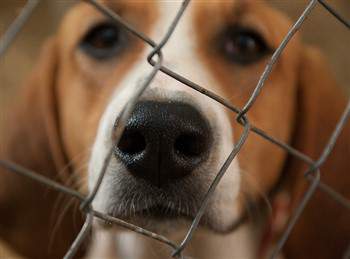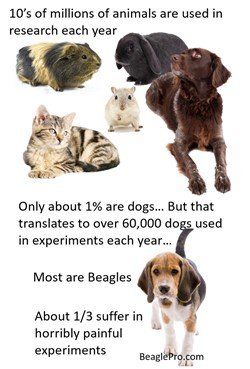Research Beagles
Beagles Used as Research Dogs
Overview
Though rates have declined since their peak in 1979, animal testing is still very prevalent. It is estimated that each year in the US, between 40 and 90 million animals are used in research facilities that include hospitals, schools, diagnostic laboratories and private firms in the pharmaceutical and biotechnology industries.
The types of animals used most often are mice, fish, rats, rabbits, guinea pigs, hamsters, farm animals, birds, cats, dogs, mini-pigs and monkeys. Only 1 to 1.5% of those animals are dogs, however that still gives a shocking number.
In the US, approximately 60,000 dogs are held in laboratories each year, with an estimated 25,000 of those subjected to painful experiments. Of the dogs that are used, a large majority of them are Beagles.
The 4 top offending countries that use Beagles are the United States, China, Japan and Australia (in Australia, the most commonly used dogs are Beagles and also Greyhounds).
Why the Beagle?
In the past, a good number of dogs (a variety of purebreds and mixed breeds) used for research were often obtained directly from pounds (a practice called pound seizure) or from Class B animal dealers.
These are essentially random sourced dogs; some are stolen, some are taken from shelters (often under the pretense of someone wanting to adopt), many scooped by from listings for 'free dog to good home' ads and other unsystematic sources.
Obtaining random dogs allowed companies to perform their testing, however two things happened that sadly, have led to the use of more Beagles:


1)
Class B dealers are disappearing (more ahead).
2)
Testing on random dogs did not/does not work for many labs. They want standardized results. They want their processes streamlined. In an effort to obtain more accurate testing results and to keep things standardized, research companies chose one particular breed for many of their purposes. And they chose the Beagle.
One reason is their size and deposition. Toy sized breeds would be too small for much of the testing and large breeds are harder to handle. In regard to breeding, Beagles often have good-sized litters and female Beagles have less pregnancy and delivery complications compared to many other breeds.
In addition, some speculate that choosing just one breed as ‘the’ breed allows workers to somehow feel that using the dogs is more ethical.
Where do labs obtain the Beagles from?
In the US, the National Institutes of Health (NIH) banned government funding for medical researchers that obtained dogs from Class B sources. This greatly cut down on the number of people who were stealing and scrounging for dogs to sell them to labs.
These sorts of dealers are all but becoming extinct. Those that remained after the new laws were enacted are unable to renew their licenses as of this year, 2016.
But at the same time, it created a huge problem for the Beagle. With a crackdown on Class B dealers, where will the dogs come from? Well, the answer is from the other common source: Class A animal dealers. The majority of the Beagles being used (and remember, we are talking about tens of thousands per year), are ‘purpose bred’ Beagles.
This is 'the' breed chosen and wanted for testing, so Beagles are being bred specifically for the use in experiments and testing. Facilities that breed Beagles for the sole purpose of selling them as lab animals are referred to as ‘Class A’ animal dealers.
Most of the dogs are sold to research facilities by the age of 1 year old and a portion of these have had devocalization surgery (an operation that removes the vocal cords so that the dog is unable to bark). At the time of this writing, devocalization for this purpose is illegal in only 5 states.
Laws dictate that each dog (under 33 pounds) is given a living area of just 8 square feet. And it is ‘recommended’ that the dogs are in cages that allow them enough height to stand.

This is a still from a video PETA took while undercover. This shows a lab worker mistreating a Beagle, squeezing his muzzle tight. This was taken at Huntingdon Life Sciences a contract research organization with a lab in the UK and one in the US.
What kind of testing are Beagles used for?
Before a pharmaceutical drug, pesticide, or chemical such as a food additive, is made available to the public, the U.S. Food & Drug Administration requires that it be rigorously tested on animals. In some cases, this includes dogs. Also, dogs are used in medical research and experimentation. Toxicity testing includes but is not limited to:
• Human drugs
- A pharmaceutical is force-fed or injected into their bodies, slowly poisoning them. What type of results are gained from this sort of testing? The FDA acknowledges that 92% of drugs that successfully pass via animal tests then go on to fail or cause harm during human clinical trials.
Opposite to that, even if a drug harms dogs, it can then go on to be deemed safe for humans.
One very apt example is aspirin. When tested on dogs, large doses were shown to cause teratogenic malformations (birth defects due to toxicity). Yet Americans take 29 billion aspirin every year.
In addition, approximately 106,000 people die each year due to medications that were deemed safe via animal testing.
• Industrial chemicals, pesticide and household products
– The list of chemicals that humans use increase each year. Tens of thousands are currently used and over 1000 are added each year. Before these can be deemed safe for humans, they undergo rigorous testing, which unfortunately involves seeing how animals react to them.
While much of this is done on mice, dogs(mostly Beagles) are used as well for some products and chemicals. During this, the substance may be applied to a patch of shaved skin, added to the animal’s food or water
or forced to be inhaled.
Humane Society International estimates that for one single pesticide to be declared safe, there are 50 experiments involving 12,000 animals. If an adverse effect occurs, this is referred to as a Clinical Endpoint. It may be something as innocuous as a skin irritation or something horrid as cancer or neurological damage.
Medical research includes but is not limited to:
• Biomedical research of heart disease
– For example, at Ohio State University, dogs were forced to run on a treadmill until they collapsed from a heart attack. If they were not dead upon falling, the dogs were killed so that the damage to their heart tissue could be studied.
• Dental research.
A shocking 76 day undercover investigation conducted by the Humane Society of the United States in 2013 revealed just how much suffering dogs endure. They discovered that researchers at Georgia Regents University pulled out the teeth of 6 dogs and placed implants in them. After the dogs healed, they were killed and their jaw bones were sawed off for the researchers to study the healed tissue. Public records show that GRU had used 186 canines in the past for various purposes.
• In veterinary schools for student training, particularly for surgery.
While many schools are now using pigs and horses, some are still using cats and dogs. Both cats and dogs are used by some schools for dissection. In addition, live dogs are used in ‘terminal surgery labs’ (most often seen in elective courses rather than required); this refers to taking a healthy dog (or cat), subjecting them to invasive surgical procedures, allowing them to recover and then euthanizing them.
• Research of eye disease
– At the University of Pennsylvania, puppies were bred to have a degenerative eye disease that results in blindness. During the study, 3-week-old Beagles had their eyes removed and then were killed.
Photos and video of this and other acts of cruelty can be seen on the Occupy for Animals site, warning that the images you will see are quite graphic, shocking and should not be seen by children.
• Other
– Surgical techniques for kidney transplants were perfected in dogs and pigs. Heart surgery techniques (coronary bypass surgery, artificial heart valve insertion, and pacemaker implants) were studied first in dogs before being used in people. While it is wonderful that there is now a canine parvovirus vaccine, it was developed due to testing on hundreds of dogs.
Living Conditions of Lab Beagles
As we touched on, dogs are kept in very small cages; however, the reality of their living conditions reaches far beyond this. These Beagles endure severe stress on a daily basis. They never know what it is like to have grass under their feet, to feel sunshine on their face, smell
fresh air or even chew on a toy. They never know what it is like to rest or sleep on a bed; the resting/sleeping surface for most are cold metal sheets or wired cages.
Bright artificial lights, loud noises, crowding, constant fear and days, weeks, months or years of distress and even sometimes agonizing pain (some toxicity testing can last up to 2 years) can all culminate into severe physiological duress. When an animal cannot endure it any longer, and literally goes ‘crazy’ from his living conditions, this is referred to as “stress-induced psychosis”.
The Effects on the Beagles
The testing, wide and varied, can leave a dog essentially unharmed, slightly harmed, seriously harmed or dead. If a Beagle is seriously harmed, he is then usually euthanized. Even dogs that are relatively healthy, but have previously been used in a lot of tests, may then be killed.
If testing was noninvasive and the dog was resilient, he may come out of it relatively unscathed. However, in many cases, surviving Beagles will suffer from anxiety (including fear of people), have no socialization skills, not be housebroken, may have trouble eating and will often be devocalized (de-barked).
Despite this, with love and a caring home, these Beagles can make for fantastic pets and there are many groups whose main purpose is to rescue and rehome the Beagles that do find freedom after living in a lab (more ahead).
Must testing on Beagles be done?


In short, no. Dogs and other animals differ in their anatomy, metabolism and genetics, which means that data cannot be extrapolated from animals to humans with sufficient accuracy. And there are many other alternatives.
Alternatives may produce better results than what testing on Beagles and other animals can provide. A term coined by William Russell and Rex Burch, two biologists from Britain who worked to reduce the number of animals that had to suffer through testing, called ‘The Three R’s’, summarizes their proposal: Replacement, Reduction and Refinement.
• Replacement
–
Use human cells in test tubes to test cancer fighting drugs and other compounds. Veterinary schools can use plastic soft-tissue organ models instead of operating on dogs.
• Reduction-
This refers to legally lowering the number of animals that need to die in order for a product to be classified as unsafe.
• Refinement
– Using better computer software to track results (which cuts down on the amount of testing needed), new and more effective pain relieving medication to treat animals that are suffering distress and better living conditions (larger cages, not being isolated) to try and reduce emotional stress. This refinement part of the proposal may actually increase the number of animals used in biomedical research, due to advances in genetic engineering research.
While many companies are abiding by ‘The Three R’s’, it by no means stops the use of animals all together and still tens of thousands of Beagles are being used in laboratories.
There are a number of agencies that have been formed to work toward lessening the number of dogs and other animals used. The Interagency Coordinating Committee for the Validation of Alternative Methods (ICCVAM) works to encourage government agencies that regulate toxicity testing to accept new testing methods.
Ways to Help
There are several ways that you can help stop the research being done to Beagles, other dogs and other animals. You may also wish to get involved with a rescue organization that works hard to save lab Beagles; they are always looking for volunteers, signatures for petitions, foster homes and adopters.
1. You can urge the FDA to stop painful animal testing via a PETA petition.
The letter is pre-written, though you can edit it if you wish. Then, all you need to do is enter your name and email address. This can be found here: Peta Petition to Step Animal Testing.
2. You can help lobby for new legislation. One portal is through
the Humane Society of the United State’s Humane Lobby Day.
There, you can volunteer or intern, make a donation that goes toward passing laws to help animals or even become a district leader for your area if one is needed.
3. You can adopt a research Beagle or donate to the cause.
Some research laboratories, when a Beagle survives and they are done experimenting on the dog, give those dogs to Beagle rescue groups. Some of the most well-known rescue groups that work to save, rehabilitate and then rehome Beagles freed from research labs include:
• The Beagle Freedom Project was started in 2010 and is now part of the non-profit organization of Animal Rescue, Media & Education (ARME). They are an amazing group that works to push legislation, inform & educate the public and petition against labs and schools. In coalition with other rescues, they extend great effort to save Beagles from being killed; dogs that they are able to free are evaluated and then fostered or adopted.
• Beagle Rescue League, Inc. is based out of Northwest New Jersey and Eastern Pennsylvania and they are connected to many other shelters out of state. They have a program called ‘Lab to Leash’ which works extensively to rehome Beagles that were used in scientific experiments.
To find local rescues in your area, you may wish to go through the above mentioned groups or do a web search for rescue groups in your town or city.
Can a Research Beagle Become an Adjusted Pet?
Frankly, it all depends. Some Beagles are so traumatized that they are never able to adjust to ‘normal’ living. But others are able to do quite well and can transition into unbelievably happy canine family members.
For example, the Beagle Freedom Project rescued 38 Beagles that were scheduled to be euthanized simply because they were no longer needed. Yet most were healthy. The majority of those dogs learned to socialize and play. They were exuberant to be free and have become adjusted, happy dogs.
What To Expect if You Adopt a Research Beagle
Most rescues will be upfront regarding a Beagle’s health. Those chosen for rehoming are free of major health issues due to their experiences in the lab, and any other conditions that are naturally occurring may be present such as allergies.
In regard to behavior, a reputable rescue will have a Beagle’s temperament assessed and let you know what areas may need to be worked on.


While there are certainly elements such as learning to interact with humans, how to play with toys, knowing that beds are made for sleeping on, learning to walk on leash, learning house training, etc. many Beagles – given time and patience – soak in the splendor of a new life and transition well.
This said, the dog may never be a social butterfly or be completely free of phobias. Please do not expect a rescued lab Beagle to be a perfectly socially adjusted dog; if the dog transitions well and shows no signs of past abuse that is fantastic, but there may always be some emotional scars.
You may or may not ever be able to find out exactly what any certain Beagle experienced while in a research facility; many do not disclose the details of this to a rescue that takes the dog in. Expect a rescued Beagle to have a number tattooed on his ear and his vocal cords removed; while this makes most dogs mute, some are still able to make soft noises.
Join us to receive updates:
Become a Free BeaglePro Member
to receive updates when we add new pages of information to this site. You will also be able to suggest a topic for us to write about. *** If you are already a Member, just reply to any newsletter with your suggestion.
You may also like:
Top Beagle Care Tips
- A great round-up of ways to keep your Beagle puppy or dog happy and healthy.
Share Us
Share
Tweet
Share
Mail
All text and photographs protected by US and International copyright laws.
Copyright. BeaglePro.com
We are a participant in the Amazon Services LLC Associates Program, an affiliate advertising program designed to provide a means for us to earn fees by linking to Amazon.com and affiliated sites.



